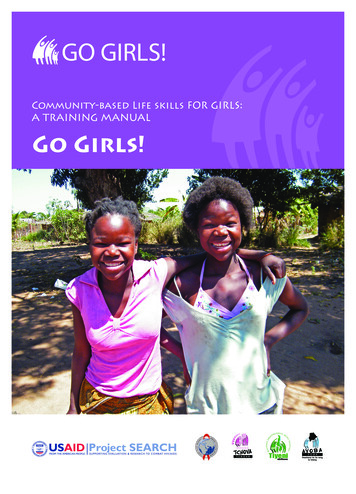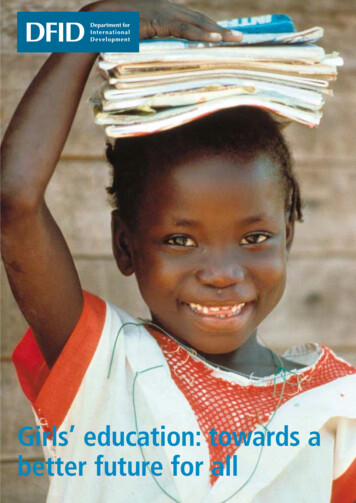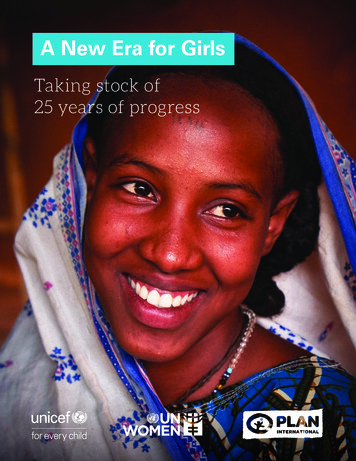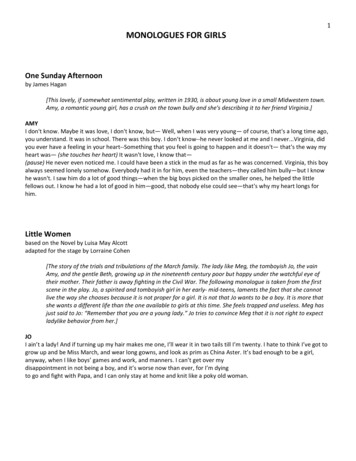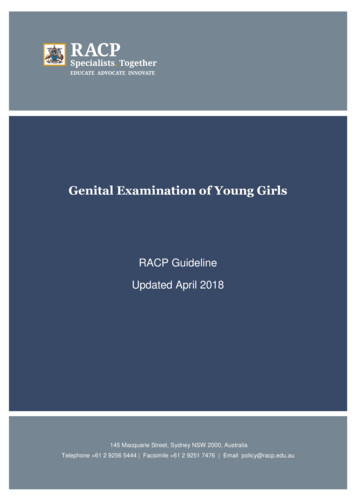
Transcription
Genital Examination of Young GirlsRACP GuidelineUpdated April 2018145 Macquarie Street, Sydney NSW 2000, AustraliaTelephone 61 2 9256 5444 Facsimile 61 2 9251 7476 Email policy@racp.edu.au
Contents1. Purpose of this Guideline . 22. Governing Principles . 23. Adopting a cultural lens . 24. Indications for a genital examination . 35. Examiner/personnel . 36. Consent . 47. Confidentiality . 58. Explanation of Findings to the Child and Parents . 59. Factors that Influence the Conduct of Genital Examinations . 59.1 Age . 59.2 Prior Sexual Experience . 69.3 Suspected or Alleged Sexual Assault . 610. Vaginal instrumentation and medication . 710.1 Speculum Examination . 710.2 Examination Under Anaesthetic . 710.3 Per Vaginal medications . 810.4 Trans-vaginal ultrasound scan . 811. Changes to Appearance of Genitalia during examination . 8Appendix: Suspected Sexually Transmissible Infections . 8A. 1 Investigations for STI pre and post puberty . 8A. 2 Suspected STI following sexual assault . 9Genital Examination of Young Girls1
1. Purpose of this GuidelineThe purpose of this guideline is to guide medical practitioners and nurses in relation to the indicationsfor, and the conduct of, genital examinations in girls and young women. Paediatricians, particularlythose involved with child protection work, may be called on to perform genital examinations of girlsand young women.This guideline may be of interest to all health professionals who conduct genital examinations on girlsand young women.This guideline does not specifically refer to examination of the anal region. It should be noted,however, that examination of the perineum and anal region is usually appropriate when girls andyoung women are examined because of suspected genital inflammation, infection or assault.2. Governing PrinciplesThe following governing principles should be considered prior to conducting a genital examination ona girl or young woman: The girl’s or young woman’s best interests (their physical and psychological health andwellbeing) are paramount and should guide all decision making. Best practice in examining girls and young women revolves around effectivecommunication. It is imperative that medical practitioners and nurses take the utmost carein explaining the procedure(s) to the girl or young woman (and her parent/guardian). The girl’s or young woman's dignity and privacy should be maintained throughout theexamination, regardless of the presence of others. The examinations of a girl’s or young woman’s genitalia should be conducted in a mannerthat minimises discomfort and distress for the patient. In particular, care should beafforded to avoid unnecessarily touching the hymen of prepubertal girls because this mightcause pain or discomfort.Medical professionals should be informed about and have familiarised themselves with any tests thatneed to be performed, the equipment required and methods of sampling for investigation prior tocommencing the examination.3. Adopting a cultural lensOver the past decade, research and treatment literature in the field of child maltreatment has becomemore responsive to cultural issues and certainly more nuanced. Health professionals working withchildren from culturally and linguistically diverse groups often find themselves with the challenge ofexploring and resolving the tension between definitions of harm in child protection practice andvarious cultural and child-rearing practices. Adopting a cultural lens means acknowledging the role ofculture in the child or young person’s life and contextualising it. For the individual practitioner,culturally competent clinical practice is about self-reflexive practice and not assumptions orgeneralisations.Genital Examination of Young Girls2
Clinicians should be aware that girls and young women from certain ethno-cultural groups may not becomfortable discussing their genitalia or sexual acts and may not want male clinicians to examinethem, or their parents may not allow it. Raman and Hodes provide a simple guide to culturallycompetent healthcare in their exploration of ‘Cultural issues in child maltreatment’. 1 The Royal Collegeof Paediatrics and Child Health in the excellent Child Protection Reader provides a well-developedsection on ‘Ethnicity and cultural perspectives in CAN’.2 The RACP policy statements on culturalcompetent practice for indigenous Aboriginal and Torres Strait Islander and Maori peoples recognisethat cultural competence must be integrated in the delivery of health services in order to reduceinstitutionalised racism.3 44. Indications for a genital examinationInspection of the genital area of girls and young women is commonly required as part of good medicalpractice. Indications include (but are not restricted to) the examination of newborn female babies, skinrashes in the genital area, urinary tract infection, enuresis, herniae and symptoms affecting the genitalarea.A genital examination might be indicated in relation to suspected or alleged: Sexually transmissible infection Pregnancy Pelvic pain or other genital symptoms or concerns Sexual assault Foreign bodyCervical cytology screening is not currently recommended until the age of 25 years.5The decision to perform a genital examination is the responsibility of the examining medicalprofessional. This decision should be based on the: Appropriateness of medical indications (including forensic medical indications), and Willingness of girl or young woman and/or parent/guardian, and Circumstances of the presentation (time, pain etc).5. Examiner/personnelMedical professionals who perform genital examinations should be appropriately trained andexperienced.Trans-vaginal ultrasound scans, examinations under anaesthetic and evaluations for suspectedsexual assault should only be performed by medical professionals who have satisfactorily completedrelevant training or are under relevant clinical supervision.Genital Examination of Young Girls3
In clinical practice, there may be requests from parents and/or child welfare agents to provide anexaminer of the same gender as the young pre-pubertal child (up to 10 years of age). Parents can bereassured that in the context of suspected sexual abuse the limited literature available suggests thatfor children the behaviour of the doctor, such as showing kindness, is more important than gender. 6However, where feasible, requests from the family or young woman in relation to the examiningdoctor should be respected.An appropriate support person should be present when examining a girl or young women. Many girlsand young women prefer the support of a trusted family member or close friend. The support personshould be a person of the girl or young woman’s choosing. Also, another professional may be presentduring the examination. Contemporary professional guidelines in relation to the role andresponsibilities of chaperones should be considered.With respect to examining a girl or young woman, the presence of a trusted family member or othersupport person should be the routine. However, the girl or young woman’s right to decline theirpresence, and the doctor’s right not to proceed with an examination without their presence, ought tobe respected. This practice provides important support for both the girl or young woman and thedoctor.6. ConsentMedical professionals need to ensure valid consent is obtained prior to conducting a genitalexamination. This is from a parent/guardian on behalf of a child or from a young woman herself and/ortheir parent or guardian. Valid consent must be voluntary, informed and consider the capacity of thegirl or young woman to consent.Medical professionals should familiarise themselves with relevant state/territory legislation regardingcapacity to consent. Capacity to consent should be considered on an individual basis and is not solelyrelated to age. Children can consent as long as they have the capacity to understand the informationand the implications of the procedure to which they are consenting. 7When parents or guardians have consented on a girl’s behalf, medical professionals should take theutmost care in explaining the procedure(s) and proceed only with the girl or young woman’s assent.Special consideration needs to be given to obtaining consent from patients who have or are: Living with an intellectual disability Experiencing mental health problems Living with Physical disability Drug or alcohol affected Culturally and linguistically diverse Injured, in pain or in shock Sleep deprivedGenital Examination of Young Girls4
Unable to give valid consentExcept in a medical emergency, genital examination should not proceed in the absence of validconsent.7. ConfidentialityGirls or young women who have the capacity to consent should be given the opportunity to talkprivately with the medical professional. The medical professional should ensure that the girl or youngwoman understands that confidentiality cannot be guaranteed in the following circumstances: Risk of serious harm to self or others Suicidal ideation Serious criminal activity Psychosis Sexual or physical abuseIn situations when assurances regarding confidentiality cannot be given, the girl or young woman andtheir guardian should be informed regarding the potential release of information. Discussion shouldinclude information regarding the professional identity of individuals who might receive thisinformation, details of how and when information will be shared and the range of uses to which it maybe put.8. Explanation of Findings to the Child and ParentsCare should be given to explaining the examination findings to the girl or young woman. Explanationsneed to be tailored to the girl’s or young woman’s level of comprehension and reassurance givenwhere appropriate.In circumstances when the parent or guardian is providing consent to the examination of a girl oryoung woman, or when the girl or young woman consents to the sharing of information, anexplanation of the examination findings should be provided by the examining doctor during theconsultation.9. Factors that Influence the Conduct of Genital Examinations9.1 AgeIn babies and toddlers genital inspection is often an important aspect of the general medicalexamination. Digital or instrumental vaginal examination is very rarely indicated in pre-pubertal girls.Allegations of sexual abuse, vaginal bleeding, vaginal discharge or suspected genital malformationmay require visual inspection of the vaginal vestibule and/or ultrasound examination. If this does notreveal the required information and further examination is deemed medically necessary, thenexamination under anaesthesia by appropriately trained medical professionals may be indicated.Genital Examination of Young Girls5
In a pubescent or post-pubertal girl, digital or instrumental examinations of the genitalia should onlybe performed with the consent of their parent/guardian or in the case of a mature minor, their consent.There should always be an agreement with the girl or young woman to examine her genitalia (assent).Privacy and confidentiality are of the utmost importance in dealing with girls and young women.Components of the examination and findings (normal and abnormal) must be communicated to thegirl or young woman at her level of comprehension.9.2 Prior Sexual ExperienceDigital or instrumental vaginal examinations are unlikely to be indicated for a girl or young woman whostates that she is NOT sexually active. If a visual inspection of the vaginal vestibule does not revealthe required information and further examination is deemed medically necessary, then aninstrumental examination may be performed (with anaesthesia if necessary) by a trained andexperienced medical professional.Medical professionals should be aware that a significant proportion of young people under 16 years ofage report having had sexual intercourse.8 However, sexual experience does not automatically meanthat an internal digital or instrumental vaginal examination is either necessary or acceptable to ayoung person.Consideratio
RACP Guideline Genital Examination of Young Girls Updated April 2018 145 Macquarie Street, Sydney NSW 2000, Australia Telephone 61 2 9256 5444 Facsimile 61 2 9251 7476 Email policy@racp.edu.au
